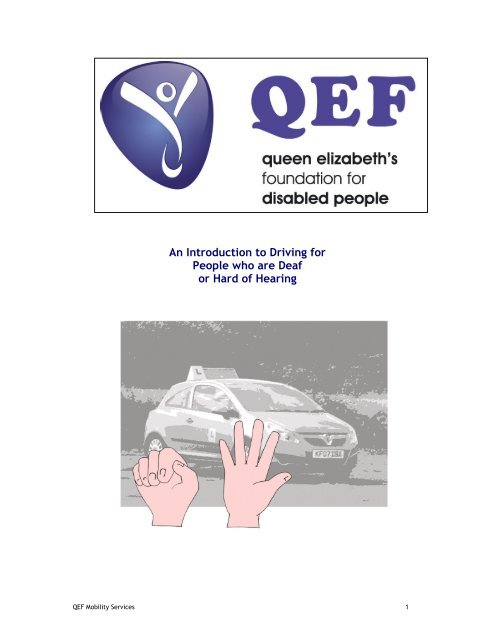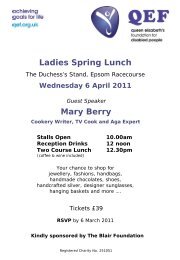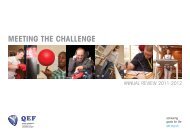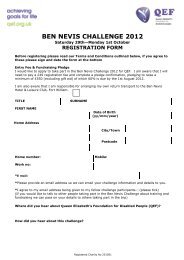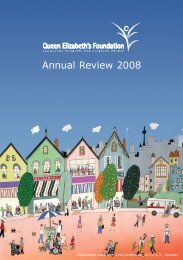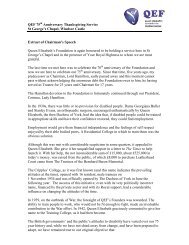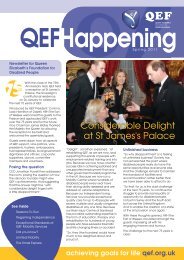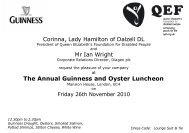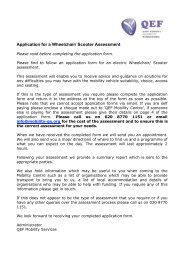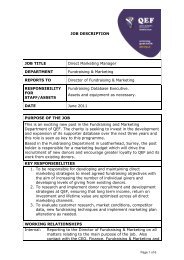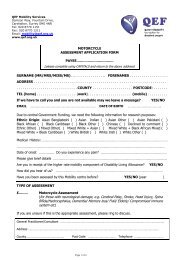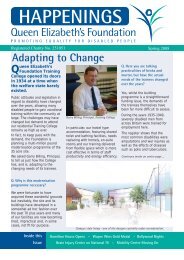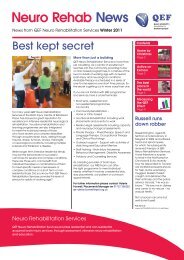An Introduction to Driving for Deaf 2012 - QEF
An Introduction to Driving for Deaf 2012 - QEF
An Introduction to Driving for Deaf 2012 - QEF
You also want an ePaper? Increase the reach of your titles
YUMPU automatically turns print PDFs into web optimized ePapers that Google loves.
<strong>An</strong> <strong>Introduction</strong> <strong>to</strong> <strong>Driving</strong> <strong>for</strong><br />
People who are <strong>Deaf</strong><br />
or Hard of Hearing<br />
<strong>An</strong> <strong>Introduction</strong> <strong>to</strong> <strong>Driving</strong> <strong>for</strong><br />
People who are <strong>Deaf</strong><br />
or Hard of Hearing<br />
<strong>QEF</strong> Mobility Services 1
I'd like <strong>to</strong> learn <strong>to</strong> drive, I am deaf – What do I need <strong>to</strong> do?<br />
There is no reason why a deaf person cannot learn <strong>to</strong> drive either a manual or<br />
au<strong>to</strong>matic car. However, you should be aware that if you pass your test in a car<br />
with au<strong>to</strong>matic transmission, you are only allowed <strong>to</strong> drive au<strong>to</strong>matics and<br />
would need <strong>to</strong> pass another test <strong>to</strong> drive a manual car. Whereas if you pass on<br />
a manual car you can drive either. This is worth considering be<strong>for</strong>e you start<br />
your lessons.<br />
Where do I begin?<br />
You need <strong>to</strong> apply <strong>for</strong> your provisional driving licence in the normal way. There<br />
is no need <strong>to</strong> notify DVLA of deafness until the age of 70 <strong>for</strong> cars or mo<strong>to</strong>rcycles<br />
(group 1 entitlement).<br />
Finding a driving instruc<strong>to</strong>r<br />
Queen Elizabeth’s Foundation Mobility Services have a database of driving<br />
instruc<strong>to</strong>rs who have completed a course of training, which includes advice <strong>for</strong><br />
teaching deaf or hard of hearing pupils. You can contact us at:<br />
Queen Elizabeth’s Foundation Mobility Services<br />
Damson Way<br />
Fountain Drive<br />
Carshal<strong>to</strong>n<br />
Surrey<br />
SM5 4NR<br />
Telephone; 020 8770 1151.<br />
Website: www.qef.org.uk/mobilityservices<br />
Email: info@mobility-qe.org<br />
Please provide us with your postcode, whether you wish <strong>to</strong> drive a manual or<br />
au<strong>to</strong>matic and if you need any adaptations. We can then find driving instruc<strong>to</strong>rs<br />
in your local area who have experience of teaching deaf and hard of hearing<br />
people <strong>to</strong> drive.<br />
Some large driving schools have instruc<strong>to</strong>rs who specialise in teaching people<br />
who are deaf, so remember <strong>to</strong> in<strong>for</strong>m them that you are deaf when applying <strong>for</strong><br />
driving lessons.<br />
How will my instruc<strong>to</strong>r teach me?<br />
The text on the pages <strong>to</strong> follow is the advice offered <strong>to</strong> <strong>Driving</strong> instruc<strong>to</strong>rs on<br />
our training course. You may find this useful <strong>to</strong> understand what you can<br />
expect from your driving instruc<strong>to</strong>r.<br />
I can sign<br />
<strong>QEF</strong> Mobility Services 2
As far as British Sign Language is concerned, ‘signing’ cannot be used by the<br />
instruc<strong>to</strong>r <strong>to</strong> assist the pupil whilst driving. This also applies <strong>to</strong> the examiner<br />
when you are taking your test. There are specific directional signs that are<br />
used <strong>for</strong> route directions. These are agreed between instruc<strong>to</strong>r and pupil at the<br />
beginning of the course. Detailed instruction will be given when the car is<br />
parked. During lessons, there will be some time spent stationary with the<br />
instruc<strong>to</strong>r. Many deaf people are able <strong>to</strong> lip read <strong>to</strong> a certain extent and<br />
instruc<strong>to</strong>rs may also use written in<strong>for</strong>mation and sketches <strong>to</strong> help teach pupils<br />
<strong>to</strong> drive.<br />
Technology<br />
A choice of assistive listening products are available <strong>to</strong> help including in-car T-<br />
loop systems.<br />
Connevans Limited<br />
54 Albert Road North<br />
Reigate<br />
Surrey<br />
RH2 9YR<br />
Tel: 01737 247571<br />
Text/minicom: 01737 243134<br />
Fax: 01737 223475<br />
Email: mail@connevans.com<br />
Website: www.connevans.com<br />
Gordon Morris Ltd.<br />
Unit 21,<br />
Wessex Park,<br />
Somer<strong>to</strong>n Business Park,<br />
Somer<strong>to</strong>n,<br />
Somerset, TA11 6SB<br />
UNITED KINGDOM.<br />
Telephone: + 44 (0) 1458 272121<br />
FAX: + 44 (0) 1458 274545<br />
E-mail: online@gordonmorris.co.uk<br />
<strong>QEF</strong> Mobility Services 3
How will I know when <strong>to</strong> change gear?<br />
Knowing when <strong>to</strong> change gear can be difficult <strong>to</strong> judge <strong>for</strong> any learner driver. It<br />
isn’t a problem specifically <strong>for</strong> the deaf learner. The deaf driver learns <strong>to</strong> feel<br />
the level of engine vibration. You will learn what it feels like when the engine<br />
is revving enough <strong>to</strong> change gear.<br />
How will I hear sirens?<br />
Some students who are deaf have expressed concerns about not hearing police<br />
sirens etc. There will be other clues <strong>to</strong> show that something is happening –<br />
other drivers pulling over, <strong>for</strong> instance. Good observations and use of mirrors<br />
are essential <strong>for</strong> safe driving. With the help of these you will spot the blue<br />
flashing lights as others would if they were listening <strong>for</strong> sirens.<br />
Breakdown Cover<br />
The AA and RAC offer support <strong>to</strong> deaf cus<strong>to</strong>mers in breakdown or accident<br />
situations. You can contact either of them via SMS (text message) on your<br />
mobile:<br />
• The AA<br />
SMS text messaging is available <strong>for</strong> use by deaf, hard of hearing or speech impaired<br />
members in a breakdown situation by calling 07900 444 999.<br />
In<strong>for</strong>mation is available in large print, audio and Braille on request. Call 0800 262 050<br />
<strong>for</strong> details. Or if you have a textphone, call 0800 32 82 810.<br />
If you have broken down and require assistance, contact the AA on 0800 887<br />
766<br />
• RAC<br />
Offer a Breakdown Text Service.<br />
Text 07855 828282.<br />
Minicom Supertel service. Call 0800 626389 <strong>for</strong> assistance.<br />
This number should be on the reverse of your membership card.<br />
Taking your Theory test<br />
The driving theory test was introduced in July 1996 as part of a package of<br />
measures <strong>to</strong> help improve road safety. The theory test is intended <strong>to</strong> ensure<br />
that all new drivers have a sound knowledge and understanding of driving and<br />
road safety be<strong>for</strong>e they are issued with a full licence <strong>to</strong> drive unaccompanied.<br />
Having successfully completed the theory test candidates must pass their<br />
practical driving test within two years; otherwise they have <strong>to</strong> retake the<br />
theory test.<br />
<strong>QEF</strong> Mobility Services 4
The <strong>Driving</strong> Standards Agency (DSA) provides a number of facilities <strong>for</strong> people<br />
with special requirements: these include <strong>for</strong>eign language voiceovers, extra<br />
time, British Sign Language interpretation and transla<strong>to</strong>r assisted tests.<br />
The theory test is made up of two parts; the multiple choice part and the<br />
hazard perception part. You need <strong>to</strong> pass both parts <strong>to</strong> pass the theory test.<br />
Once you have passed the theory test, you can apply <strong>to</strong> take your practical<br />
driving test.<br />
Physical Disabilities<br />
Most theory testcentres are accessible by wheelchair. Where a candidate’s<br />
nearest test centre is not wheelchair accessible, the DSA will arrange <strong>for</strong> an<br />
alternative accessible venue <strong>to</strong> be used or, in very special cases, can arrange<br />
<strong>for</strong> the test <strong>to</strong> be conduced at the candidate’s home.<br />
The theory test is based entirely on multiple choice questions that require<br />
correct answers from a number of options. Candidates do this by <strong>to</strong>uching a<br />
square (like a computer key) on the screen. However, if a candidate has<br />
difficulty doing this, a member of the test centre staff will be on hand <strong>to</strong><br />
provide help.<br />
<strong>Deaf</strong> Candidates<br />
You can ask <strong>to</strong> take the theory test in British sign language (BSL). The BSL<br />
interpretation will be alongside the standard test questions and answers. If you<br />
do not use BSL, an interpreter can be taken in<strong>to</strong> the test centre. This can be<br />
arranged through the theory test cus<strong>to</strong>mer services section. There is no extra<br />
fee <strong>for</strong> either requirement.<br />
Tests can be booked on: www.dsa.gov.uk<br />
Highway Code and Theory Test: There are videos, CDs and DVDs available <strong>to</strong><br />
view. You will find these in your local bookshop. TSO sell the official DSA<br />
theory test <strong>for</strong> car drivers CD Rom or DVD<br />
If you have a general enquiry regarding product availability or would prefer an<br />
alternative payment procedure, contact Cus<strong>to</strong>mer Services by telephone +44<br />
(0)870 600 5522.<br />
Speech impaired cus<strong>to</strong>mers can also communicate via text telephone on tel:<br />
+44 (0)870 240 3701.<br />
You can practice the multiple choice test online through the DSA website:<br />
www.dsa.gov.uk/mockpaper/theoryintro.htm<br />
<strong>QEF</strong> Mobility Services 5
The <strong>to</strong>uch screen computer testing equipment has a facility <strong>for</strong> a BSL signer in<br />
the corner of the screen <strong>for</strong> those with reading difficulties.<br />
The test is presented one question at a time and candidates respond by<br />
<strong>to</strong>uching the correct answer on the screen.<br />
City Lit: (The centre <strong>for</strong> adult learning) run <strong>Deaf</strong> Education and Learning<br />
Support Course <strong>Driving</strong> Test Theory <strong>for</strong> terminology and understanding the test<br />
questions. The course is taught in British Sign Language.<br />
For more details contact City Lit:<br />
City Lit<br />
Keeley Street<br />
Covent Garden<br />
London<br />
WC2B 4BA<br />
Web: www.citylit.ac.uk<br />
Switchboard: 020 7492 2600<br />
Enrolments: 020 7831 7831<br />
Fax: 020 7492 2735<br />
<strong>Deaf</strong> Education<br />
Tel 020 7492 2725<br />
Fax 020 7492 2745<br />
textphone 020 7492 2746<br />
deafedu@citylit.ac.uk<br />
The minicom number 0870 0106372 is available <strong>for</strong> test bookings and enquiries<br />
or you can email: cus<strong>to</strong>mercare@pearson.com<br />
Dyslexia and other reading difficulties<br />
People with dyslexia, or who have other reading difficulties, can listen <strong>to</strong> the<br />
questions on headphones with an English or Welsh voiceover. They can also<br />
request double the normal length of time <strong>to</strong> complete the multiple choice part<br />
of the theory test. However, they will be required <strong>to</strong> provide a written<br />
statement <strong>for</strong> their requirements from a teacher, educationalist or other<br />
suitably qualified professional. If a candidate cannot provide such a statement<br />
they should call the theory test enquiry line on 0870 01 01 372 and speak <strong>to</strong> a<br />
member of the ‘Special Needs’ team <strong>to</strong> agree what other <strong>for</strong>m of requirement<br />
can be accepted.<br />
MORE ABOUT THE TEST<br />
Booking a Test<br />
<strong>QEF</strong> Mobility Services 6
To book a theory test you will need:<br />
• a valid UK driving licence<br />
• a valid debit or credit card <strong>for</strong> payment.<br />
Theory Test telephone booking no:<br />
You can book a theory test online, over the phone or by post at:<br />
<strong>Driving</strong> Standards Agency<br />
Cus<strong>to</strong>mer Services<br />
PO BOX 381<br />
Sal<strong>for</strong>d<br />
Postcode: M50 3UW<br />
Email: cus<strong>to</strong>mercare@pearson.com<br />
Phone: 0300 200 1122<br />
Minicom: 0300 200 1166<br />
Fax: 0300 200 1177<br />
Welsh Speakers: 0300 200 1133<br />
In addition <strong>to</strong> English and Welsh, voiceovers are available in the following<br />
languages: Albanian, Arabic, Bengali, Can<strong>to</strong>nese, Dari, Farsi, Gujarati, Hindi,<br />
Kashmiri, Kurdish, Mirpuri, Polish, Portuguese, Punjabi, Push<strong>to</strong>, Spanish,<br />
Tamil, Turkish, Urdu.<br />
Candidates who wish <strong>to</strong> take the theory test in another language may need <strong>to</strong><br />
arrange <strong>for</strong> an interpreter <strong>to</strong> accompany them – they should call the Helpline<br />
<strong>for</strong> further details.<br />
Practical Test telephone booking no:<br />
You can book a practical driving test online, over the phone or by post at the<br />
address below. You will need a valid debit or credit card and your driving<br />
licence number.<br />
If you book a test by post you will need <strong>to</strong> download an application <strong>for</strong>m or<br />
obtain one from your driving instruc<strong>to</strong>r or your local practical test centre.<br />
<strong>Driving</strong> Standards Agency<br />
PO Box 280<br />
Newcastle-upon-Tyne<br />
Postcode:NE99 1FP<br />
Email: bookings@dsa.gsi.gov.uk<br />
Phone: 0300 200 1122<br />
Minicom: 0300 200 1144<br />
<strong>QEF</strong> Mobility Services 7
Fax: 0300 200 1155<br />
Welsh Speakers: 0300 200 1133<br />
When booking a practical driving test you must in<strong>for</strong>m the DSA of any special<br />
requirements or disabilities. Extra time <strong>for</strong> the test is allowed so that the<br />
examiner can talk <strong>to</strong> you about your disability and any adaptations fitted <strong>to</strong> the<br />
vehicle. Regardless of the type of disability, you will still take the same<br />
driving test as any other candidate.<br />
Someone with mild hearing impairment should advise the DSA, so that the<br />
examiner may speak more loudly or turn <strong>to</strong>wards them when speaking.<br />
For a person with profound deafness, examiners have cards with written<br />
instructions which can be used. Alternatively you are entitled <strong>to</strong> take an<br />
interpreter with you <strong>to</strong> translate instructions in<strong>to</strong> sign language. The<br />
interpreter must be at least 16 years old and must not be the driving<br />
instruc<strong>to</strong>r. They must also not interfere with the test in any way.<br />
The candidate must provide the interpreter as the DSA does not employ them,<br />
and the person booking the test must also in<strong>for</strong>m DSA at the time of booking<br />
that there will be an extra person in the car. See below <strong>for</strong> further in<strong>for</strong>mation<br />
on interpreters.<br />
If a test cannot be conducted due <strong>to</strong> a lack of communication between<br />
candidate and examiner then it must be terminated <strong>for</strong> safety reasons. It is<br />
there<strong>for</strong>e in the candidate’s interest <strong>to</strong> provide the DSA with all the relevant<br />
in<strong>for</strong>mation when booking the test.<br />
Interpreters <strong>for</strong> Practical Tests<br />
RNID<br />
You can contact the In<strong>for</strong>mation Line free by telephone or textphone, or send<br />
an email, fax or letter:<br />
19-23 Feathers<strong>to</strong>ne Street, London EC1Y 8SL<br />
Telephone: 0808 808 0123 (freephone)<br />
Textphone: 0808 808 9000 (freephone)<br />
Fax:: 020 7296 8199<br />
SMS: 0780 000 0360<br />
Email: in<strong>for</strong>mationline@rnid.org.uk<br />
Whichever way you choose <strong>to</strong> contact them, please include your full postal<br />
address as they often only send in<strong>for</strong>mation through the post. They also provide<br />
a lot of relevant in<strong>for</strong>mation on their website.<br />
<strong>QEF</strong> Mobility Services 8
Signature<br />
Signature was <strong>for</strong>mally established as the Council <strong>for</strong> Advancement of<br />
Communication with <strong>Deaf</strong> People in 1982 by a partnership of organisations<br />
working with and representing deaf and deaf/blind people. They have<br />
administered the national registers <strong>for</strong> BSL/English interpreters, Lipspeakers<br />
and other communication professionals since 1992.<br />
Language Service Professionals (LSPs) – lip speakers as well as sign language<br />
interpreters will require payment <strong>for</strong> their services.<br />
Problems paying <strong>for</strong> an Interpreter:<br />
From Oc<strong>to</strong>ber 1999 the Disability Discrimination Act stipulates that service<br />
providers must make reasonable adjustments, and the provision of an LSP<br />
would count as such. Lip speakers are often used <strong>to</strong> assist in the theory test<br />
and this can be paid <strong>for</strong> by the DSA.<br />
Contact Details:<br />
Signature<br />
Mersey House<br />
Mandale Business Park<br />
Belmont<br />
Durham DH1 1TH<br />
Tel: 0191 383 1155<br />
Text: 0191 383 7915<br />
Fax: 0191 383 7914<br />
Email: durham@signature.org.uk<br />
Advice <strong>for</strong> <strong>Driving</strong> Instruc<strong>to</strong>rs<br />
<strong>Deaf</strong>ness is not classed as a driver disability. No restrictions are placed on a full<br />
licence when a deaf driver has passed the driving test. The profoundly deaf<br />
(those who have no hearing at all) do benefit when filling in the Department of<br />
Transport’s application <strong>for</strong>m <strong>for</strong> the driving test by disclosing that they are<br />
<strong>to</strong>tally deaf. This ensures that the <strong>Driving</strong> Examiner is properly prepared and<br />
extra time is allocated <strong>for</strong> slower communication.<br />
<strong>Driving</strong> instruc<strong>to</strong>rs are not often called upon <strong>to</strong> tackle this type of training and<br />
some are reluctant <strong>to</strong> undertake the task because of their limited experience.<br />
<strong>Deaf</strong>ness can make communication with a hearing driving instruc<strong>to</strong>r more<br />
difficult at first. It requires the instruc<strong>to</strong>r <strong>to</strong> be able <strong>to</strong> adapt their teaching<br />
technique slightly. The instruc<strong>to</strong>r does not need <strong>to</strong> learn sign language but the<br />
instruc<strong>to</strong>r’s face should be seen clearly by the learner. Your pupil cannot lip-<br />
<strong>QEF</strong> Mobility Services 9
ead you and watch the road at the same time. You will not be able <strong>to</strong> give<br />
instructions while the pupil is driving along. Wait until the car has s<strong>to</strong>pped at a<br />
quiet part of the road.<br />
When you speak <strong>to</strong> a deaf person, remember <strong>to</strong>:<br />
• Speak clearly<br />
• Do not shout<br />
• Keep your head still<br />
• Do not speak until the deaf person can see your lips clearly. Try <strong>to</strong> move<br />
your lips a little more than you normally do<br />
• Be patient<br />
It is vital <strong>to</strong> realise that lip-reading is largely guesswork because so many words<br />
look the same. For example, the sounds, M, B and P look exactly the same and<br />
the lip-reader cannot SEE any difference between the words PETER, BETTER<br />
and METER. There are thousands of such ambiguities – compare COLD, OLD,<br />
HOLD and GOLD. Lip reading is made more difficult because sounds such as N,<br />
T, D, K, L, G are ‘invisible’. The lips do not move when these sounds are made.<br />
Some deaf people are very good at lip reading so clear speech is important.<br />
Face <strong>to</strong> face conversation, demonstration, written notes and the use of visual<br />
aids will cover all requirements. Unsatisfac<strong>to</strong>ry response is likely <strong>to</strong> be the<br />
fault of the instruc<strong>to</strong>r rather than the learner.<br />
At the outset it is necessary <strong>to</strong> establish what is the best means of<br />
communication. For example, putting a thumb up will mean "good" whereas<br />
putting a thumb down will mean "bad".<br />
<strong>Introduction</strong> <strong>to</strong> Controls<br />
<strong>Introduction</strong> <strong>to</strong> controls of the vehicle, as is the practice, will be by<br />
demonstration when the car is stationary. Emphasis must be made <strong>to</strong> show<br />
which limb has <strong>to</strong> operate each control, as demonstration is the method which<br />
will be used <strong>to</strong> communicate. For instance, the right leg being the limb used<br />
<strong>for</strong> the accelera<strong>to</strong>r and the footbrake: tap your own right leg as you place it<br />
over the accelera<strong>to</strong>r and the footbrake. Similarly when demonstrating the use<br />
of the clutch, tap your own left leg as you demonstrate <strong>to</strong> the pupil how <strong>to</strong><br />
operate this pedal. This will establish <strong>to</strong> the pupil what is being asked when<br />
you tap either leg.<br />
Mirrors<br />
Explain the need <strong>for</strong> effective use; pointing first <strong>to</strong>wards the eyes and then <strong>to</strong><br />
the mirrors can be a good reminder.<br />
Steering<br />
<strong>QEF</strong> Mobility Services 10
Demonstrate <strong>to</strong> the pupil. It is important <strong>to</strong> use illustrations and visual aids.<br />
Establish at the outset, while stationary, how important it is <strong>to</strong> look well<br />
ahead. If it is seen that the eyes have dropped with the resultant wander of<br />
the vehicle, point <strong>to</strong> pupil’s eyes followed by a hand movement straight ahead.<br />
Visual aids can also assist in showing the correct way <strong>to</strong> turn the steering<br />
wheel.<br />
Gears<br />
Following explanation of the positions of each gear and their uses, establish the<br />
method <strong>to</strong> be used <strong>to</strong> communicate which gear needs <strong>to</strong> be selected when on<br />
the move.<br />
Speed first – then gear<br />
Recognising when it is necessary <strong>to</strong> change gear will be known by the<br />
awareness of different speeds, but also by feel.<br />
<strong>QEF</strong> Mobility Services 11
Clutch<br />
Locate with left foot, tapping left leg; explain use and how <strong>to</strong> operate, again<br />
using visual aids. Establish the code which will be used <strong>for</strong> instruction on use of<br />
the clutch when the vehicle is moving. Place left hand horizontally, as near <strong>to</strong><br />
the dashboard as possible. When requiring the clutch <strong>to</strong> be pressed, palm<br />
facing down, move hand downwards. For lifting the clutch, palm facing down,<br />
move hand upwards very slowly.<br />
Accelera<strong>to</strong>r<br />
Having explained what this is, where it is and how <strong>to</strong> use it, establish the<br />
method you will use <strong>to</strong> indicate when you require more or less pressure. Raise<br />
right hand in horizontal position with palm facing downwards. As advised with<br />
left hand <strong>for</strong> the clutch, move right hand up or down <strong>to</strong> demonstrate the<br />
pressure required.<br />
<strong>QEF</strong> Mobility Services 12
Footbrake<br />
Following introduction <strong>to</strong> the use, make sure your pupil knows what will be the<br />
signal you will use when braking is required. Raise right hand again in<br />
horizontal position, with palm facing downwards, but this time locate your<br />
hand a little further <strong>to</strong> the left in order <strong>to</strong> indicate the use of the middle<br />
pedal. As advised with left hand <strong>for</strong> the clutch, move hand up or down <strong>to</strong><br />
demonstrate the pressure required.<br />
Clutch and accelera<strong>to</strong>r co-ordination<br />
Use both hands (palms facing down) extended horizontally and work in unison –<br />
one up and other down like a see-saw. Biting point is shown <strong>to</strong> be when hands<br />
are level.<br />
<strong>QEF</strong> Mobility Services 13
S<strong>to</strong>pping<br />
While stationary, demonstrate by raising the right foot from the accelera<strong>to</strong>r<br />
and transferring it <strong>to</strong> the footbrake, followed by progressive pressure. Later,<br />
when on the move, the right hand will be used as already described. How much<br />
pressure required will be shown by the amount of downward movement of the<br />
hand. Just be<strong>for</strong>e the vehicle is stationary and the left foot is required <strong>to</strong> press<br />
the clutch, the left hand should be raised alongside the right and pressed down<br />
fully.<br />
Positioning<br />
Use the right hand (back of hand facing pupil) with fingers extended. To<br />
indicate necessity <strong>to</strong> move further <strong>to</strong> the right, move hand <strong>to</strong>wards the right.<br />
Similarly, when requiring the vehicle <strong>to</strong> travel nearer <strong>to</strong> the left, move hand<br />
<strong>to</strong>wards the left.<br />
Turning corners<br />
<strong>QEF</strong> Mobility Services 14
When requiring a pupil <strong>to</strong> take a road on the left:<br />
a) If it is the first road:<br />
Place right hand up <strong>to</strong> the windscreen with one finger pointing upwards,<br />
immediately followed by moving the whole hand <strong>to</strong> the left.<br />
When requiring the pupil <strong>to</strong> take a road on the right:<br />
a) If it is the first road:<br />
Place right hand up <strong>to</strong> the windscreen with one finger pointing upwards,<br />
immediately followed by moving the whole hand <strong>to</strong> the right.<br />
b) If it is the second road:<br />
Place right hand up <strong>to</strong> the windscreen with two fingers pointing<br />
upwards, immediately followed by moving the whole hand <strong>to</strong> the right or left.<br />
Ensure the two fingers are clearly visible and not held at an angle so they look<br />
like only one finger.<br />
<strong>QEF</strong> Mobility Services 15
Roundabouts<br />
Make a round movement with your hand and hold up the number of fingers <strong>to</strong><br />
show which exit: 1st, 2nd, 3rd etc.<br />
Traffic lights<br />
With palm upward and fingers closed, ‘explode’ fingers outwards <strong>to</strong> describe<br />
the light coming on. You can describe the light more fully by doing three lights<br />
one beneath the other like on the real thing. Then give the direction in the<br />
usual way.<br />
<strong>QEF</strong> Mobility Services 16
Further signals <strong>for</strong> instructions<br />
When requiring the car <strong>to</strong> s<strong>to</strong>p at the side of the road, use the same movement<br />
with the arm as advised <strong>for</strong> positioning and follow this by an up and down<br />
movement, similar <strong>to</strong> the Highway Code signal <strong>for</strong> “I am going <strong>to</strong> slow down or<br />
s<strong>to</strong>p”.<br />
Work on your signing <strong>to</strong>gether<br />
Whilst <strong>QEF</strong> has taken every care <strong>to</strong> provide the in<strong>for</strong>mation in this<br />
document, we cannot in any circumstances accept liability arising out of or<br />
in connection with the use of this in<strong>for</strong>mation or any reliance placed on it<br />
by any person. <strong>QEF</strong> does not endorse or make any representation <strong>to</strong> the<br />
quality, cost or availability of the services listed.<br />
Further In<strong>for</strong>mation<br />
The Queen Elizabeth’s Foundation Mobility Services run a one day training<br />
course accredited by the Open College Network <strong>for</strong> people who are deaf or<br />
hard of hearing and are looking <strong>to</strong> start driving:<br />
Benefits<br />
A Practical Approach <strong>to</strong> <strong>Driving</strong> <strong>for</strong> <strong>Deaf</strong> People<br />
one-day workshop (awaiting OCN accreditation)<br />
A Practical Approach <strong>to</strong> <strong>Driving</strong> <strong>for</strong> <strong>Deaf</strong> People provides delegates with the<br />
in<strong>for</strong>mation they need: from finding a driving instruc<strong>to</strong>r <strong>to</strong> choosing and<br />
maintaining their first car.<br />
Course Overview<br />
<strong>QEF</strong> Mobility Services 17
The programme includes:<br />
• The practicalities of owning a car<br />
• Alternatives <strong>to</strong> driving<br />
• Getting your first licence<br />
• Getting your first car<br />
• Practical driving session<br />
• Basic car maintenance<br />
• What makes a good driver<br />
Course in<strong>for</strong>mation<br />
Duration<br />
Location<br />
1 day<br />
Queen Elizabeth’s Foundation Mobility Services, Damson Way,<br />
Fountain Drive, Carshal<strong>to</strong>n, Surrey SM5 4NR<br />
How <strong>to</strong> apply<br />
Please contact: Queen Elizabeth’s Foundation Mobility Services <strong>for</strong> more<br />
in<strong>for</strong>mation:<br />
Telephone: 020 8770 1151<br />
Fax: 020 8770 1211<br />
Email: info@mobility-qe.org<br />
<strong>QEF</strong> Mobility Services 18


